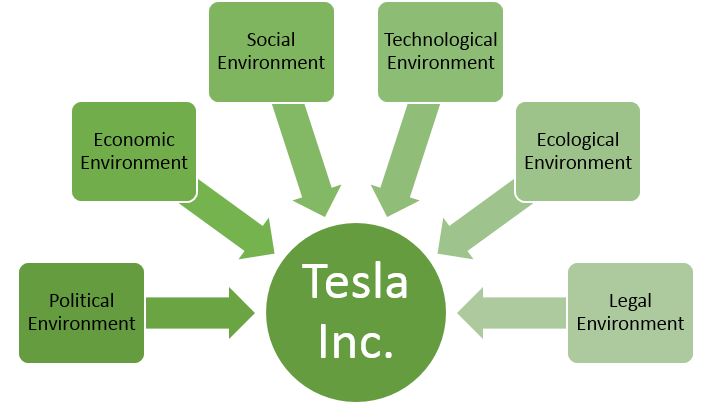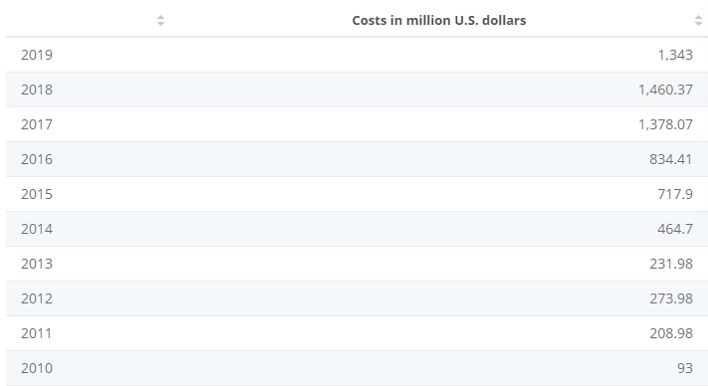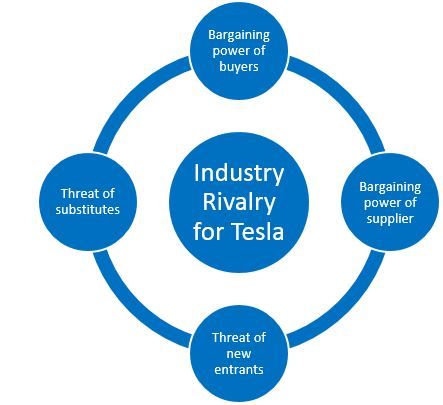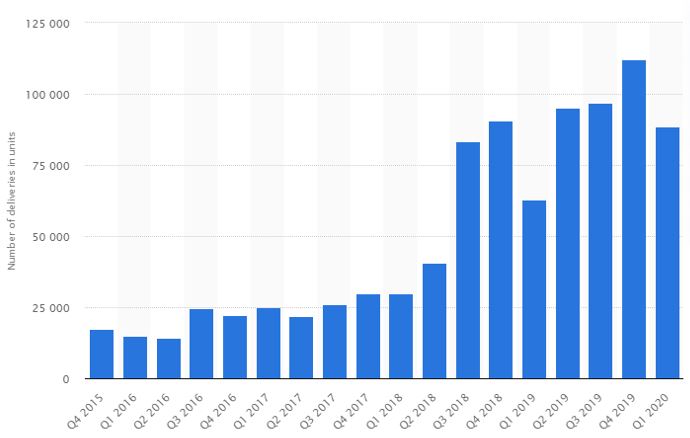Introduction
External and Internal Environment Analysis of Tesla will be evaluated in this blog. Analysis of internal and external marketing and organizational audit equip a company with relevant information and key data that helps companies to make better decision.
A car company, Tesla, has been selected for this report. Tesla Inc. is a US based technology company which was established in 2003. The company makes electric cars, batteries, and solar panels priced affordably for average consumers (Tesla, 2020). The company produced about 367,500 pieces of vehicles in 2019, it has 48,016 employees (United States Securities and Exchange Commission, 2020).
You may also like to read in below blog posts: Ansoff Matrix for Vodafone Porter’s Five Forces model of Vodafone Stakeholder analysis for Vodafone Strategic planning for Vodafone
External and Internal Environment Analysis of Tesla: PESTEL of Tesla
Full form of PESTEL is Political, Economic, Social, Technological, Ecological/Ethical, and Legal environment. Application of PESTEL model implies critical evaluation of the external environment of a business and helping a company make decision.

Political Environment: Political environmental factors such as political parties, democracy, freedom of opinions, regional political relationship with other countries, political decision affect a company widely (Turnbull and Valla, 2013). Analysis of this element of PESTEL helps a company to understand the factors and make decision wisely. Tesla has presence in industrially developed nations such as in the USA, China, Germany, France, Italy, Australia, Canada, UK and other European countries (Thinknum, 2020). Geo-political relations of US with rest of the countries intensively affect Tesla. Trade war between US and China poses a major threat for Tesla. The Detroit News (2019) reported that China imposed $75B worth US goods including cars in response to US’s decision of imposing tariff on Chinese supplies. As a result of this conflicts, Tesla’s price will increase in China, which is a major market for the company, which will affect sales.
Economic Environment: Economic environment refers to GDP, Per capita income, interest rate, employment, inflation etc. which have implications on any company (Aghazadeh, 2015). Origin country of Tesla, the USA, is economically strong country with high GDP, per capita income, the countries where Tesla has operations also have sustainable economic situation offering good business for Tesla. Per capita income in US is $65,112, Germany with 54,560, China with $18,170 and UK with $45,350 (Forbes (2019) has forecasted that demand for electric cars will dominate the market by 2041 by reducing 13m barrels of oil per day. Such attitude and perceptions by common people reveal that the demand for solar and electric powered cars will be peaking in coming years.
Technological Environment: Technological advance of a country, people’s acceptance for technology, technological adaptability widely affect a high-tech company which should think critically before making the marketing strategies (Mangram, 2012). Tesla itself is a high-tech company and the cars it manufacturers are equipped with state of the art technologies and facilities.

Above figure 2 shows that Tesla has been investment intensively in recent years form 2017. This implies the passion for technologies of the company. Such intensive investment resulted in most modern, attractive and high-tech cars in the market by Tesla.
Ecological/Ethical Environment: Concern for the environment and ethics is on the rise worldwide amid increasing global pollution and rise of the sea levels. In such scenario, Tesla can play important role based on the fact that their cars will not pollute the environment because they do not consume oil and emit smoke (Tesla, 2020). Secondly, many components of the cars are run by solar power. Above analysis reveal that electric cars manufactured by Tesla will be of great preferences in near future.
Legal Environment: Legal environment, business laws and regulations, privacy of customers, employment laws play great role in a business environment (Shaw, 2012). The Guardian (2018) reported that the CEO of Tesla, Elon Musk, advised his employees to work 12 hours a day and 6 days a week. Such advice goes against the employment laws and many of the employees consider the advice as inhuman.
External and Internal Environment Analysis of Tesla: SWOT of Tesla
SWOT analysis is a strategic model to evaluate internal strength, weakness and external opportunities and threats. The analysis has been applied on Tesla below.
| Strength | Weakness |
| The most prominent strength of Tesla car is their features which cannot be seen available in others. Tesla Cars have auto pilot mode, they are electric which means no need fuel, have interior families such as web browsing, streaming; can rise speed as much as 100 km/h in 10 sec. (CNBC LLC., 2017). All above excellent features have gained special attention of car lovers around the world.Brand value of Tesla has increased by 60% in 2018 at $9.4B which is ranked 8th which was ranked by WPP BrandZ (Clean Technica, 2020). This implies that Tesla has gained much recognition and acceptance in a short time.Tesla has a strong tem of employees and R&D which has made the company reach ambitious plans. Tesla invested $1343M in R&D in 2019, it has enabled Tesla to bring new features and equip the company will capabilities (Statista, 2020). | Tesla doesn’t have active participation in developing and emerging economies where great demand and potentials remain in future. As a result, the risks are not evenly distributed.CEO of Tesla Elon Musk is known for making ambitious goals and imposing the same on employees requiring them to work extra hours and meet the goals (The Guardian, 2018). Such criticism play negative role on Tesla and discourage potential talents from joining Tesla. |
| Opportunities | Threat |
| Concern form environment protection will rise more in future. Such concern will motivate people to purchase electric and solar powered cars (Forbes, 2019). In such cases, Tesla’s vehicles will be of great demand.World’s emerging economies will play big role and people living is emerging nations such as Brazil, India, Russia, South Africa and China will consume more expensive supplies in future (FAO, 2020). Thus, Tesla can enhance its marketing and sales horizon by actively participating in these countries. | Existing rivalry in the automotive market is huge where competitors such as Toyota, Nissan, Hyundai, Mercedes Benz, and Ford play great role and they are game changer. Tesla has a market share of only 1.29% in the US automobile industry (Statista-1, 2020).Amid crisis of COVID 19, Tesla and other car makers will face sales decrease in the market because of the slowing economy and less business activities. |
External and Internal Environment Analysis of Tesla: Porter’s Five Forces Model for Tesla
Porter’s Five Forces is marketing audit tool to evaluate competitive market scenario in an industry (Lee et al., 2013).

Bargaining power of buyers-High: Bargaining power of buyers is high because there are many alternative competitors where target customers can purchase similar cars from Ford, Nissan or Mercedes Benz (McDaniel et al., 2017). Given the high poor of customers, Tesla should offer extra benefits through adding features not offered by others.
Bargaining power of suppliers-Medium: Bargaining power of suppliers is medium because there are many sensitive and valuable supplies needed to make an electric cars and these supplies of high quality are not available to all suppliers (De Pin, 2015). Therefore, Tesla should categorize the suppliers and should put high importance on those who are potential.
Threat of new entrants-High: Threat of new entrants is relatively low because electric car manufacturing is an investment intensive industry (Yu, 2015). Thus, a newcomer cannot establish a potential competitor overnight.
Threat of substitutes-High: Threat of substitute for Tesla is high because there are a number of options open for customers instead of Tesla cars. Customers can go for fuel driven vehicle. In this case, Tesla should carefully target the specific market.
Industry Rivalry-Medium: Electric cars and solar powered cars are relatively new concept in the world, this not many companies have started manufacturing such high-utility cars (Song, Gu and Li, 2017). Tesla should do aggressive segmentation and marketing across all potential countries in the world. This will give them first mover advantage in new countries where electric cars are new.
Unique Selling Point (USP) of Tesla:
Tesla cars are uniquely designed and crafted cars with features and designers not found available in majority of cars. Such USP have enabled the brand to capture special attention of customer’s perception.
Autopilot: Tesla cars are equipped with driving assistance system which can help with steering, brakes (Aaron, 2015). The vehicles can also make lane change when a driver indicates lane change signal.
Supercharger: Tesla provides superchargers and these are the fastest chargers in the US now (CNBC LLC., 2020). Drivers can go more than 600m only with one-hour charge. This is a unique attributes of Tesla’s car.
Automated software update: Tesla relentlessly add new features in the cars and these features are downloaded and installed automatically in the cars because the cars have built-in internet connections (CNBC LLC., 2020).
Auto streaming and web browsing: Since Tesla cars have internet connections, customers can get the facilities of auto streaming and web browsing inside the vehicle (Moritz et al., 2015). This provides them great competitive advantage.
Competitive performance of Tesla: Strategies, growth, sales, trends, profitability
An energetic team of winners: ELon Musk, the CEO of Tesla, is known for making highly ambitious goals and encouraging the teams to achieve them (Ramsey, 2015). The team has also followed the same approach of achieving goals which seem unachievable at the beginning. Such winning spiriting of the teams have made it possible for the company to gradually build a successful company. However, the leadership of Musk is questionable because many doubt on his high ambitions and persuasions to employees to work more and more. As a result the employee (who directly report to Musk) turnover rate is 44% which is one of the highest in the industry (Crain Communication Inc., 2020). Therefore, top management should be more logical and be responsible about his impact.
Emerging presence in major countries: Tesla has marketing activities in industrially developed nations such as in Japan, China, Germany, France, Italy, USA, UK etc. (Thinknum, 2020). Clearly, the strategy is first to promote marketing communications in developed nations.

Above demonstration in figure 4 shows that sales grew widely since 2018 which is a result of strong presence in the markets where there are demands. However, for more growth and sustainable business, Tesla have to expand business in emerging nations as suggested earlier.
Attractive designs and performance of vehicles: Tesla’s cars are famously known for its attractive designs, good performance, speed, innovative features (Terenchenko, Karpukhin and Kurmaev, 2015). These features and factors have helped Tesla widely to succeed in marketing and operations.
Superchargers: This feature has added new and unique value to Tesla’s cars because customers can now recharge the vehicle in one hour and can move more than 600 miles uninterruptedly (CNBC LLC., 2020). This is one of the reasons which explain the high sales growth of Tesla’s car.
Reference List
Anghel, L.D., Constantinescu, M. and Caescu, Ş.C., 2013. INNOVATION WITHIN THE STRATEGIC MARKETING MANAGEMENT OF INDUSTRIAL SMEs AS A RESPONSE TO THE ECONOMIC CRISIS. Transformations in Business & Economics, 12.
Aghazadeh, H., 2015. Strategic marketing management: Achieving superior business performance through intelligent marketing strategy. Procedia-Social and Behavioral Sciences, 207, pp.125-134.
Aaron, K., 2015. Elon musk says self-driving tesla cars will be in the us by summer. The New York Times.
Andersen, M., Dauner, T., Lang, N. and Palme, T., 2017. What Automakers Can Learn from the Tesla Phenomenon. BCG Perspectives. URL: https://www. bcgperspectives. com/content/articles/automotive-what-automakers-can-learnfrom-tesla-phenomenon/Accessed, 17(11).
CNBC LLC., 2017. These are the 11 coolest features of the Tesla Model S. Retrieved from: https://www.cnbc.com/2017/11/17/tesla-model-s-best-features.html [Assessed on 4 May 2020]
Clean Technica, 2020. Tesla’s Brand Value Jumped 60% In 2018. Retrieved from: https://cleantechnica.com/2019/07/14/teslas-brand-value-jumped-60-in-2018/ [Assessed on 4 May 2020]
Crain Communication Inc., 2020. Tesla burning through execs like cash. Retrieved from: https://www.autonews.com/executives/tesla-burning-through-execs-cash [Assessed on 7 May 2020]
Ceglinski, P., 2016. Use of strategic marketing management tools in contemporary enterprises. Marketing i Zarządzanie, 46(5), pp.9-16.
Dogu, E. and Albayrak, Y.E., 2018. Criteria evaluation for pricing decisions in strategic marketing management using an intuitionistic cognitive map approach. Soft Computing, 22(15), pp.4989-5005.
De Pin, F., 2015. How Tesla integrates Shared Value principles with Ecosystem Innovation to build sustainable competitive advantage. Università Ca’Foscari Venezia.
Edvardsson, B., Klaus, P., Payne, A. and Frow, P., 2014. Developing superior value propositions: a strategic marketing imperative. Journal of Service Management.
Forbes, 2019. Electric Models To Dominate Car Sales By 2040, Wiping Out 13m Barrels A Day Of Oil Demand. Retrieved form: https://www.forbes.com/sites/mikescott/2019/06/10/electric-models-to-dominate-car-sales-by-2040-wiping-out-13m-barrels-a-day-of-oil-demand/#50ccb0bd342e [Assessed on 2 May 2020]
FAO, 2020. BRICS countries well placed to take a leadership role in helping eradicate global hunger and poverty by 2030. Retrieved from: http://www.fao.org/asiapacific/news/detail-events/en/c/896254/ [Assessed on 4 May 2020]
Foxall, G., 2014. Strategic Marketing Management (RLE Marketing). Routledge.
Gilmore, A., Kraus, S., O’Dwyer, M. and Miles, M., 2012. Strategic marketing management in small and medium-sized enterprises. International Entrepreneurship and Management Journal, 8(2), pp.141-143.
Hajli, N. ed., 2015. Handbook of research on integrating social media into strategic marketing. IGI Global.
Jones, D.B. and Richardson, A.J., 2017. Origins of sports car marketing: early 20th Century British cycle-cars. Journal of Historical Research in Marketing.
Lee, K.C., Lee, H., Lee, N. and Lim, J., 2013. An agent-based fuzzy cognitive map approach to the strategic marketing planning for industrial firms. Industrial Marketing Management, 42(4), pp.552-563.
Line, N.D. and Runyan, R.C., 2014. Destination marketing and the service-dominant logic: A resource-based operationalization of strategic marketing assets. Tourism Management, 43, pp.91-102.
Mangram, M.E., 2012. The globalization of Tesla Motors: a strategic marketing plan analysis. Journal of Strategic Marketing, 20(4), pp.289-312.
McDaniel, A., Jeltema, T., Profumo, S. and Storm, E., 2017. Multiwavelength analysis of dark matter annihilation and RX-DMFIT. Journal of Cosmology and Astroparticle Physics, 2017(09), p.027.
Moritz, M., Redlich, T., Krenz, P., Buxbaum-Conradi, S. and Wulfsberg, J.P., 2015, August. Tesla Motors, Inc.: Pioneer towards a new strategic approach in the automobile industry along the open source movement?. In 2015 Portland International Conference on Management of Engineering and Technology (picmet) (pp. 85-92). IEEE.
Moutinho, L. and Vargas-Sanchez, A. eds., 2018. Strategic Management in Tourism, CABI Tourism Texts. Cabi.
Mullins, J., Walker, O.C. and Boyd Jr, H.W., 2012. Marketing management: A strategic decision-making approach. McGraw-Hill Higher Education.
New York Times, 2014. Offering More Than Luxury, Supercars Draw a Crowd of Makers and Buyers. Retrieved from: https://www.nytimes.com/2014/03/08/business/international/market-is-crowded-for-high-end-cars.html [Assessed on 9 May 2020]
Ngo, L.V. and O’Cass, A., 2012. Performance implications of market orientation, marketing resources, and marketing capabilities. Journal of Marketing Management, 28(1-2), pp.173-187.
Proctor, T., 2014. Strategic marketing: an introduction. Routledge.
Rashid, N.R.N.A., Rahman, N.I.A. and Khalid, S.A., 2014. Environmental corporate social responsibility (ECSR) as a strategic marketing initiatives. Procedia-Social and Behavioral Sciences, 130(0), pp.499-508.
Rossi, M., Vrontis, D. and Thrassou, A., 2014. Agro business in a changing competitive environment–Campania firms’ strategic, marketing and financial choices. World Review of Entrepreneurship, Management and Sustainable Development 5, 10(2-3), pp.312-333.
Statista, 2020. Tesla – R&D spending 2010-2019. Retrieved from: https://www.statista.com/statistics/314863/research-and-development-expenses-of-tesla/ [Assessed on 3 May 2020]
Shaw, E.H., 2012. Marketing strategy. Journal of Historical Research in Marketing, 4(1), pp.30-55.
Statista-1, 2020. Tesla’s U.S. market share – December 2019. Retrieved form: https://www.statista.com/statistics/519579/market-share-of-tesla-in-the-united-states/ [Assessed on 5 May 2020]
Song, J., Gu, C.W. and Li, X.S., 2017. Performance estimation of Tesla turbine applied in small scale Organic Rankine Cycle (ORC) system. Applied Thermal Engineering, 110, pp.318-326.
Ramsey, M.I.K.E., 2015. Tesla to upgrade cars through the Internet. The Wall Street Journal.
Statista-1, 2020. Tesla’s vehicle deliveries by quarter – YTD Q1 2020. Retrieved from: https://www.statista.com/statistics/502208/tesla-quarterly-vehicle-deliveries/ [Assessed on 7 May 2020]
Simberova, I., 2014. Company strategic marketing management–synergic approach and value creating. Acta Universitatis Agriculturae et Silviculturae Mendelianae Brunensis, 58(6), pp.543-552.
Super Cars, 2020. Car Brands Full List. Retrieved from: https://www.supercars.net/blog/all-brands/ [Assessed on 9 May 2020]
Sahaf, M.A., 2019. Strategic marketing: making decisions for strategic advantage. PHI Learning Pvt. Ltd..
Tesla, 2020. Tesla’s mission is to accelerate the world’s transition to sustainable energy. Retrieved from: https://www.tesla.com/about [Assessed on 8 May 2020]
Thinknum, 2020. Tesla’s growing worldwide presence. Retrieved from: https://media.thinknum.com/articles/teslas-growing-worldwide-presence/ [Assessed on 2 May 2020]
The Detroit News, 2019. Carmakers alarmed by latest round of Chinese tariffs. Retrieved from: https://www.detroitnews.com/story/business/autos/2019/08/23/carmakers-alarmed-over-latest-round-chinese-tariffs/2096792001/ [Assessed on 2 May 2020]
Turnbull, P.W. and Valla, J.P., 2013. Strategies for international industrial marketing. Routledge.
The World Bank Group, 2020. GDP per capita (current US$). Retrieved from: https://data.worldbank.org/indicator/NY.GDP.PCAP.CD [Assessed on 2 May 2020]
The Guardian, 2018. Tesla workers say they pay the price for Elon Musk’s big promises. Retrieved from: https://www.theguardian.com/technology/2018/jun/13/tesla-workers-pay-price-elon-musk-failed-promises [Assessed on 3 May 2020]
Terenchenko, A., Karpukhin, K. and Kurmaev, R., 2015. Features of operation of electromobile transport in the conditions of Russia. Paper of EVS, 28.
Tesla-2, 2020. Tesla. Roadster. Retrieved from: https://www.tesla.com/roadster [Assessed on 8 May 2020]
United States Securities and Exchange Commission, 2020. Tesla Inc. Retrieved from: https://www.sec.gov/Archives/edgar/data/1318605/000156459020004475/tsla-10k_20191231.htm [Assessed on 1 May 2020]
Van den Steen, E., 2015. Tesla Motors. Harvard Business School Publishing.
West, D.C., Ford, J. and Ibrahim, E., 2015. Strategic marketing: creating competitive advantage. Oxford University Press, USA.
Wilson, R.M. and Gilligan, C., 2012. Strategic marketing management. Routledge.
Yu, C.J., 2015. Competitive Analysis on Battery Electricc Vehicle (BEV) Market: A Case Study of Tesla Motor.
